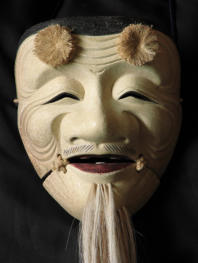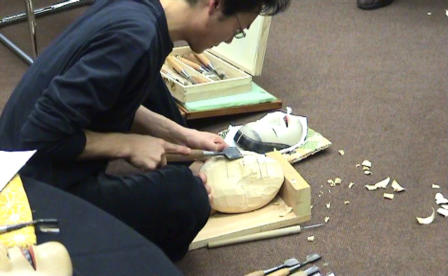NAVIGATION
SOCIAL
CONTACT
e-mail: info@theworldthroughwoodeneyes.co.uk


The
Noh
theatre
is
a
highly
stylised
form
of
expression
which
is
a
composite
of
several
elements,
music,
song,
dance
drama,
scenic
elements
and
props,
exquisite
brocade
costumes,
and
haunting
masks.
The
plays
themselves
are
very
simple
and
usually
revolve
around
plots
which
include
subject
matter
like
love,
revenge,
pity,
jealousy,
and
samurai
spirit.
In
many
cases
the
plots
lack
coherence
and avoid the usual dramatic contrasts found in plays performed elsewhere.
The
Noh
theatre
is
unique
and
it
was
Zeami
Motokiro(1363-1443)
who
brought
Noh
theatre
to
its
flowering.
Zeami
was
able
to
transform
what
had
been
essentially
a
country
form
of
entertainment
possessing
ritual
overtones
into
a
remarkable
total
theatrical
experience.
Zeami
later
went
on
to
produce
a
series
of
documents
in
which
he
discusses
the
principles
of
the
Noh.
Not
only
do
the
documents
tell
us
much
about
the
early
development
of
the
Noh
during
the
middle
ages,
a
development
well
grounded
in
all
aspects
of
Japanese
life
and
culture
at
that
time,
but
they
clearly
outline the nature of the actors craft.
Despite
the
generally
low
status
of
the
actor
during
the
period,
Zeami
became
a
great
celebrity.
Very
little
is
known
about
him
except
that
he
was
a
child
actor
in
his
fathers
troupe,
and
by
the
time
he
was
twelve,
his
talents
were
well
developed
and
recognized.
The
recognition
came
from
the
Shogun
Ashikaga
Yoshimitsu(1358-1408)
who
was
an
important
political
figure
and
patron
of
the
arts,
and
supported Zeami in his work.
Zeami’s
father
died
when
he
was
twenty-two,
leaving
him
to
continue
the
family
tradition.
It
was
at
this
time
that
Zeami
set
down
the
experiences
of
his
father
and
extended
them
with
his
own
observations
as
a
performer.
The
troupe
enjoyed
the
patronage
of
the
Shogun
Yoshimitsu
until
his
death
in
1408.
After
this
time
Zeami
lost
favour
and
problems
continued
until
he
was
banished
to
the
island
of
Sado
in
his
seventy-second
year,
in
1434.
Just
before
his
death
in
1443
he
was
allowed to return to the mainland.
His
writings
were
only
intended
for
a
small
circle
of
his
collaborators
with
the
sole
function
of
ensuring
the
passing
on
of
professional
matters
from
one generation of actors to another. He could never have realized therefore how widely read they would become so far beyond his homeland.
Noh
as
a
classical
dramatic
art
is
often
seen
as
being
little
more
than
a
frozen
tradition,
and
an
ancient
museum
piece.
But
after
six
centuries
it
has
slowly
evolved
into
a
major
classical
art
form.
The
Noh
is
performed
on
a
special
type
of
stage
unlike
any
other.
In
the
early
days
it
was
performed
in
temples
and
shrines
and
later
a
special
stage
was
built
out
doors
with
the
seating
area
for
the
audience
in
a
separate
building
with
an
open
area
in
between.
Modern
Noh
stages
are
built
with
the
stage
area
and
the
seating
for
the
audience
under
the
same
roof,
even
so
the
white
gravel
area
which separated the stage and the auditorium remains as a reminder of the original.
Noh
dramas
are
depicted
in
song
and
dance
combining
a
number
of
different
elements.
There
is
vocal
music
in
the
form
of
chant.
Instrumental
music
provided
by
an
orchestra
composed
of
flutes
and
drums.
Acting
techniques
consisting
of
actions,
posturing
and
dances.
The
simple
symbolic
setting
elements
and
props,
exquisite
brocade
costumes
and
the
haunting
masks
combine
to
provide a form of theatrical expression which is ancient and timeless.
Due
to
the
complexity
of
the
Noh
drama
it
is
best
to
respond
to
Noh
drama
on
an
emotional
level
and
without
intellect.
Thus
for
many
it
is
the
magnificent
costumes
and
the
inanimate
yet
infinitely
expressive masks that will provide the greatest enjoyment.
It
is
Zeami’s
writings
which
provide
the
most
substantial
basis
for
research
on
mask
carvers
and
the
classification
of
masks.
The
Noh
mask
is
an
object
of
great
beauty
and
value,
and
treasured
by
the
great
Noh
families
and
institutions.
Many
of
the
masks
used
today
date
back
several
centuries,
being
handed
down
from
one
generation
to
another.
The
masks
are
unique
and
considered
to
be
major achievements of Japanese art and culture, superior to any other type of theatre mask to be found anywhere else in the world.
Although
Noh
actors
respect
the
nature
of
the
mask
as
a
work
of
art
in
its
own
right,
they
consider
it
wrong
to
treat
it
as
something
only
to
be
preserved
in
glass
cases
in
museums
and
temples.
Noh
masks
are
not
mere
objects
and
in
no
way
can
they
be
considered
complete
and
effective
until
the
actor
works
with
the
mask
onstage,
in
performance,
and
with
all
other
elements
of
the
Noh
performance.
The
more
the
mask
is
used
in
context, the more spiritual depth it acquires.
Over
the
years
many
great
masks
have
been
copied,
in
some
cases
to
a
degree
where
it
is
difficult
to
distinguish
the
original
from
the
copy.
Inevitably
there
have
been
poor
copies
but
there
have
been
cases
where
the
skill
of
the
copier
has
exceeded
that
of
the
original
creator.
It
has
always
been
a
practice
to
make
copies
and
it
matters
little
if
the
copy
or
the
original
is
used
providing
that
it
is
totally
expressive
on
stage,
in
performance.
Masks
have
been
used
in
Japan
throughout
the
ages
in
religious
festivals
and
ceremonies
and
it
is
important
to
consider
the
various
types
of
mask
which
led
to
the
development
of
the
Noh
masks.
The
wearing
of
masks
is
generally
believed
to
metamorphose
the
wearer
into
supernatural
entities
and
deities,
and
endowing
him
with
powers
of
a
supernatural
nature,
both
mental
and
physical.
Gigaku
is
an
ancient
form
of
mask
drama
which
came
to
Japan
from
China
sometime
during
the
7th
century.
Some
two
hundred
of
the
masks
exist
in
Japan
to
this
day.
The
masks
cover
the
head
completely
and
are
carved
from
camphor
or
paulownia
wood,
or
made
from
dry
lacquer.
The
Gigaku
was
superceded
by
Bugaku,
a
dance
drama
performed
with
or
without
masks.
The
masks
of
the
Bugaku
are
smaller
than
those
used
in
Gigaku,
they
cover
the
front
of
the
face
but
are
larger
than the Noh masks. Paulownia, Japanese cypress or cherry wood is used, and a higher degree of carving and finishing is seen.
The
next
development
is
seen
in
the
Buddhist
style
faces
of
saints
and
deities
of
Gyodo,
a
ceremonial
Buddhist
procession
using
masks
of
a
finer
quality and their influence is most clearly seen in the masks of the Noh.
Another
form
of
performance
is
known
as
Mibu
Kyogen
and
found
in
the
Mibu
Temple
in
Kyoto
and
uses
masks
similar
to
those
in
the
Noh.
The
temple possesses a fine collection of such masks, some of them created in the fourteenth century.
There
are
some
two
hundred
and
fifty
types
of
Noh
masks
divided
into
five
main
groups
revengeful
spirits,
deities,
men
and
women
and
demons,
the
demons,
literary
demons
symbols
of
human
passion,
expressing
the
essential
traits
of
the
character
that
they
represent.
There
are
times
when
the
mask
is
not
used,
in
which
case
the
actor
there
are
no
females
in
the
Noh
must
keep
his
face
completely
immobile
and
expressionless
it
is
the
mask and not the actors face which is the essence of the character.
A
variation
of
main
types
is
the
Okina
mask,
which
is
said
to
have
existed
in
the
tenth
century.
Okina
masks
have
a
special
name
‘kiri-ago’
cut
jaw
and
differ
from
the
Noh
mask,
which
is
one-piece
and
inaminate,
by
being
constructed
in
two
pieces
that
are
divided
at
the
mouth
line
and
joined
with
rough
string.
Some
also
have
pompom
like
eyebrows
and
long
whispy
beards,
all
of
them
have
expressions
of
happiness
and
contentment.
The
Okina
mask
is the only mask in the Noh theatre which is put on while on the stage.
Some
of
the
most
beautiful
masks
are
those
of
the
female
characters.
The
faces
of
the
young
and
middle-aged
women
superficially
appear
to
be
the
same,
on
closer
examination it is six different hairline styles which distinguish one from another.
At
the
present
time
there
are
many
professional
and
amateur
sculptors
of
Noh
masks,
some
of
them
priests,
all
of
them
devoted
to
the
preservation
of
an
art
form
which
reflects
the
highest
achievement
in
Japanese
art
and
culture.
The
master
Ujiharu
Nagasawa
is
the
leading
influence
on
many
of
the
new
generations
of
masters,
among
which
the
most
important
are
Hisao
Suzuki
and
Nohjin-kai.
This
group
under
the
leadership
of
Suzuki
is
devoted
to
the
preservation,
development
and
popularization
of
the
Noh
masks internationally.
The
carving
of
the
Noh
mask
or,
as
the
masters
prefer,
the
striking
of
the
mask,
starts
with
the
selection
of
the
wood.
The
word
to
‘make’
is
never
used.
The
Japanese
word
used
is
‘utsu’
meaning
to
carve
and
imbue
one’s
spirit
into
the
mask
being
created.
The
carving
and
painting
of
the
mask
creates
a
unique
object
which
is
the
product
of
a
strict discipline following traditional laws-it is a strenuous and demanding experience, fulfilling and rewarding.
The
selection
of
the
wood
is
of
prime
importance.
Most
of
the
masks
are
carved
from
the
rare
Japanese
cypress-hinoki.
It
is
used
due
to
its
great
durability,
its
fine
grain,
and
light
colour.
The
wood
must
be
well
seasoned
but
not
completely
dry.
Careful
selection
is
critical
to
avoid
later
warping
which
would
distort
the
expression
of
the
finished
mask.
It
is
not
uncommon
for
the
master
to
carve
the
mask
allowing
for
possible
warping,
particularly
in
the
delicate
female
masks.
Hinoki
possesses
a
remarkable
fragrance
which,
in
itself,
gives
pleasure
and
inspiration
during
the
carving
of the mask.
Many
of
the
tools
used
are
peculiar
to
Japan
and
made
of
a
special
alloy
of
soft
iron
and
steel
made
only
in
Japan,
often
by
masters
of
national
importance.
Then
there
are
long
handled,
double
edged
saws
which
cut
on
the
back
stroke
and
eliminate
much
of
the
strain
and
energy
wastage
experienced
using
conventional
Western
saws.
There
is
a
vast
range
of
chisels
used,
each
one
sharpened
to
a
highly
polished,
razor
sharp
finish
on
Japanese water stones.
First
the
general
shape
of
the
mask
is
cut
with
a
saw
and
large
chisels,
this
is
followed
by
the
roughing
out
of
the
features
with
medium
sized
chisels,
the
small
detail
is
then
cut
with
finer
chisels.
At
this
stage
the
inside
of
the
mask
is
hollowed
out.
The
earlier
stages
of
carving
the
mask
are
carried
out
with
the
master
sitting
on
a
based
board
to
which
a
block
of
wood
is
fixed,
the
block
of
hinoki
is
gripped
against
the
wood
with
the
feet.
During
the
carving
a
series
of
card
templates
are
used
to
check
the
mask
at
the
various
stages
of
development,
this
is
to
ensure
the
preservation
of
the
correct
shape
and
character
of
each
feature
and
the
mask
as
a
whole.
The
Noh
mask
can
take
as
long
as
three
months
to
make.
On
completion
of
the
carving
process
and
before
painting
the
master
will
contemplate
the
mask,
looking at it from various angles and drawing in the detail for the final painting.
The
painting
of
the
mask
begins
with
the
preparation
of
a
unique
form
of
gesso
which
is
made
by
finely
crushing oyster shells and mixing the powder with a
refined
glue
made
from
the
bones
of
a
small
Japanese
deer.
Some
thirteen
coats
of
this
mixture
is
applied
to
the
mask
laying
it
on
with
a
wide
brush
moved
across
the
face
in
one
direction.
This
base,
when
completed,
must
be
allowed
to
dry
thoroughly.
It
is
at
this
stage
that
hammered
out
brass
eye
and
teeth
covers
are
made and carefully applied to the masks of characters requiring this type of detail.
Final
colour
and
detail
painting
is
now
applied.
Some
masks
require
an
additional
coloured
ground,
this
is
produced
from
traditional
pigments
and
metallic additives. Hair, whiskers and other black details are painted on with ink produced by grinding ink sticks in water on an ink stone.
The
long
process
of
producing
the
Noh
mask
is
now
complete.
A
fine
silk
cord
is
attached
to
the
mask
through
specially
prepared
holes
in
the
side
of
the
mask,
this
will
be
used
by
the
actor
to
tie
the
mask
onto
his
head.
Finally
the
mask
will
be
carefully
put
into
a
fine
brocade
bag
and
additionally a wooden box. Now the mask is ready for delivery to the actor.
John M. Blundall
The Noh Theatre
of Japan

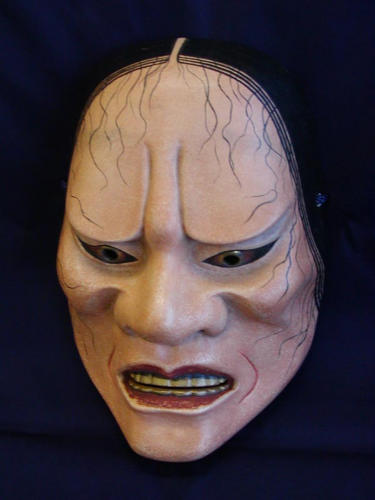
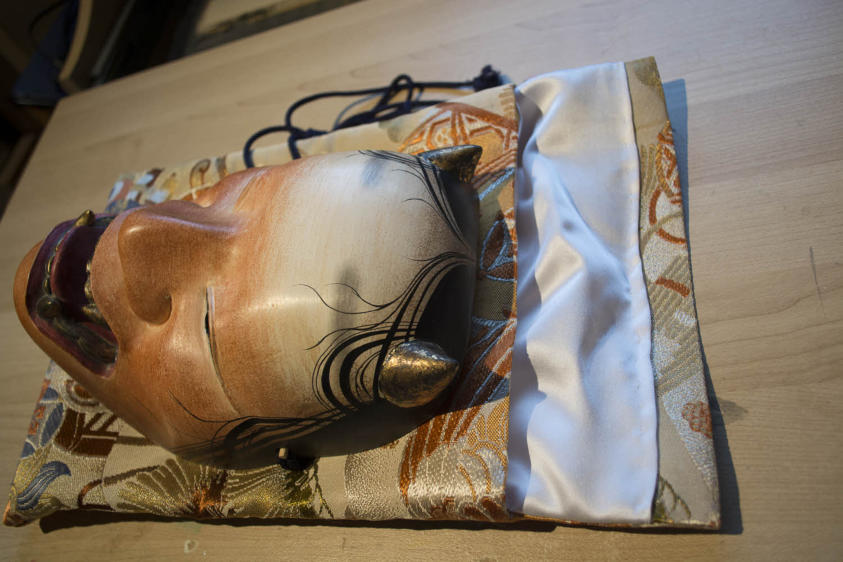


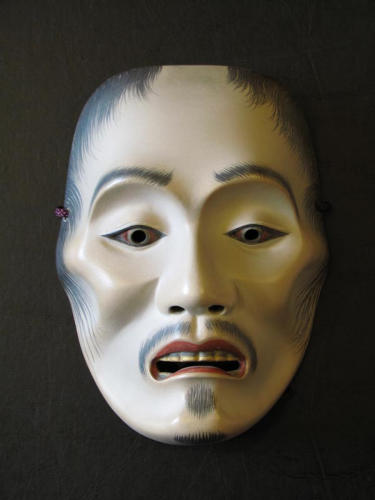

CONTACT
e-mail: info@theworldthroughwoodeneyes.co.uk
SOCIAL

The
Noh
theatre
is
a
highly
stylised
form
of
expression
which
is
a
composite
of
several
elements,
music,
song,
dance
drama,
scenic
elements
and
props,
exquisite
brocade
costumes,
and
haunting
masks.
The
plays
themselves
are
very
simple
and
usually
revolve
around
plots
which
include
subject
matter
like
love,
revenge,
pity,
jealousy,
and
samurai
spirit.
In
many
cases
the
plots
lack
coherence
and
avoid
the
usual
dramatic
contrasts
found
in
plays
performed elsewhere.
The
Noh
theatre
is
unique
and
it
was
Zeami
Motokiro
(1363-1443)
who
brought
Noh
theatre
to
its
flowering.
Zeami
was
able
to
transform
what
had
been
essentially
a
country
form
of
entertainment
possessing
ritual
overtones
into
a
remarkable
total
theatrical
experience.
Zeami
later
went
on
to
produce
a
series
of
documents
in
which
he
discusses
the
principles
of
the
Noh.
Not
only
do
the
documents
tell
us
much
about
the
early
development
of
the
Noh
during
the
middle
ages,
a
development
well
grounded
in
all
aspects
of
Japanese
life
and
culture
at
that
time,
but
they
clearly
outline the nature of the actors craft.
Despite
the
generally
low
status
of
the
actor
during
the
period,
Zeami
became
a
great
celebrity.
Very
little
is
known
about
him
except
that
he
was
a
child
actor
in
his
fathers
troupe,
and
by
the
time
he
was
twelve,
his
talents
were
well
developed
and
recognized.
The
recognition
came
from
the
Shogun
Ashikaga
Yoshimitsu(1358-1408)
who
was
an
important
political
figure
and
patron
of
the
arts,
and
supported
Zeami
in
his work.
Zeami’s
father
died
when
he
was
twenty-two,
leaving
him
to
continue
the
family
tradition.
It
was
at
this
time
that
Zeami
set
down
the
experiences
of
his
father
and
extended
them
with
his
own
observations
as
a
performer.
The
troupe
enjoyed
the
patronage
of
the
Shogun
Yoshimitsu
until
his
death
in
1408.
After
this
time
Zeami
lost
favour
and
problems
continued
until
he
was
banished
to
the
island
of
Sado
in
his
seventy-
second
year,
in
1434.
Just
before
his
death
in
1443
he
was allowed to return to the mainland.
His
writings
were
only
intended
for
a
small
circle
of
his
collaborators
with
the
sole
function
of
ensuring
the
passing
on
of
professional
matters
from
one
generation
of
actors
to
another.
He
could
never
have
realized
therefore
how
widely
read
they
would
become
so far beyond his homeland.
Noh
as
a
classical
dramatic
art
is
often
seen
as
being
little
more
than
a
frozen
tradition,
and
an
ancient
museum
piece.
But
after
six
centuries
it
has
slowly
evolved
into
a
major
classical
art
form.
The
Noh
is
performed
on
a
special
type
of
stage
unlike
any
other.
In
the
early
days
it
was
performed
in
temples
and
shrines
and
later
a
special
stage
was
built
out
doors
with
the
seating
area
for
the
audience
in
a
separate
building
with
an
open
area
in
between.
Modern
Noh
stages
are
built
with
the
stage
area
and
the
seating
for
the
audience
under
the
same
roof,
even
so
the
white
gravel
area
which
separated
the
stage
and
the
auditorium remains as a reminder of the original.
Noh
dramas
are
depicted
in
song
and
dance
combining
a
number
of
different
elements.
There
is
vocal
music
in
the
form
of
chant.
Instrumental
music
provided
by
an
orchestra
composed
of
flutes
and
drums.
Acting
techniques
consisting
of
actions,
posturing
and
dances.
The
simple
symbolic
setting
elements
and
props,
exquisite
brocade
costumes
and
the
haunting
masks
combine
to
provide
a
form
of
theatrical
expression
which is ancient and timeless.
Due
to
the
complexity
of
the
Noh
drama
it
is
best
to
respond
to
Noh
drama
on
an
emotional
level
and
without
intellect.
Thus
for
many
it
is
the
magnificent
costumes
and
the
inanimate
yet
infinitely
expressive
masks that will provide the greatest enjoyment.
It
is
Zeami,s
writings
which
provide
the
most
substantial
basis
for
research
on
mask
carvers
and
the
classification
of
masks.
The
Noh
mask
is
an
object
of
great
beauty
and
value,
and
treasured
by
the
great
Noh
families
and
institutions.
Many
of
the
masks
used
today
date
back
several
centuries,
being
handed
down
from
one
generation
to
another.
The
masks
are
unique
and
considered
to
be
major
achievements
of
Japanese
art
and
culture,
superior
to
any
other
type
of
theatre
mask to be found anywhere else in the world.
Although
Noh
actors
respect
the
nature
of
the
mask
as
a
work
of
art
in
its
own
right,
they
consider
it
wrong
to
treat
it
as
something
only
to
be
preserved
in
glass
cases
in
museums
and
temples.
Noh
masks
are
not
mere
objects
and
in
no
way
can
they
be
considered
complete
and
effective
until
the
actor
works
with
the
mask
onstage,
in
performance,
and
with
all
other
elements
of
the
Noh
performance.
The
more
the
mask
is used in context, the more spiritual depth it acquires.
Over
the
years
many
great
masks
have
been
copied,
in
some
cases
to
a
degree
where
it
is
difficult
to
distinguish
the
original
from
the
copy.
Inevitably
there
have
been
poor
copies
but
there
have
been
cases
where
the
skill
of
the
copier
has
exceeded
that
of
the
original
creator.
It
has
always
been
a
practice
to
make
copies
and
it
matters
little
if
the
copy
or
the
original
is
used
providing
that
it
is
totally
expressive
on
stage,
in
performance.
Masks
have
been
used
in
Japan
throughout
the
ages
in
religious
festivals
and
ceremonies
and
it
is
important
to
consider
the
various
types
of
mask
which
led
to
the
development
of
the
Noh
masks.
The
wearing
of
masks
is
generally
believed
to
metamorphose
the
wearer
into
supernatural
entities
and
deities,
and
endowing
him
with
powers
of
a
supernatural
nature,
both
mental
and
physical.
Gigaku
is
an
ancient
form
of
mask
drama
which
came
to
Japan
from
China
sometime
during
the
7th
century.
Some
two
hundred
of
the
masks
exist
in
Japan
to
this
day.
The
masks
cover
the
head
completely
and
are
carved
from
camphor
or
paulownia
wood,
or
made
from
dry
lacquer.
The
Gigaku
was
superceded
by
Bugaku,
a
dance
drama
performed
with
or
without
masks.
The
masks
of
the
Bugaku
are
smaller
than
those
used
in
Gigaku,
they
cover
the
front
of
the
face
but
are
larger
than
the
Noh
masks.
Paulownia,
Japanese
cypress
or
cherry
wood
is
used,
and a higher degree of carving and finishing is seen.
The
next
development
is
seen
in
the
Buddhist
style
faces
of
saints
and
deities
of
Gyodo,
a
ceremonial
Buddhist
procession
using
masks
of
a
finer
quality
and
their
influence
is
most
clearly
seen
in
the
masks
of
the
Noh.
Another
form
of
performance
is
known
as
Mibu
Kyogen
and
found
in
the
Mibu
Temple
in
Kyoto
and
uses
masks
similar
to
those
in
the
Noh.
The
temple
possesses
a
fine
collection
of
such
masks,
some
of
them created in the fourteenth century.
There
are
some
two
hundred
and
fifty
types
of
Noh
masks
divided
into
five
main
groups
revengeful
spirits,
deities,
men
and
women
and
demons,
the
demons,
literary
demons
symbols
of
human
passion,
expressing
the
essential
traits
of
the
character
that
they
represent.
There
are
times
when
the
mask
is
not
used,
in
which
case
the
actor
there
are
no
females
in
the
Noh
must
keep
his
face
completely
immobile
and
expressionless
it
is
the
mask
and
not
the
actors
face
which is the essence of the character.
A
variation
of
main
types
is
the
Okina
mask,
which
is
said
to
have
existed
in
the
tenth
century.
Okina
masks
have
a
special
name
‘kiri-
ago’
cut
jaw
and
differ
from
the
Noh
mask,
which
is
one-piece
and
inaminate,
by
being
constructed
in
two
pieces
that
are
divided
at
the
mouth
line
and
joined
with
rough
string.
Some
also
have
pompom
like
eyebrows
and
long
whispy
beards,
all
of
them
have
expressions
of
happiness
and
contentment.
The
Okina
mask
is
the
only
mask
in
the
Noh theatre which is put on while on the stage.
Some
of
the
most
beautiful
masks
are
those
of
the
female
characters.
The
faces
of
the
young
and
middle-aged
women
superficially
appear
to
be
the
same,
on
closer
examination
it
is
six
different
hairline
styles
which
distinguish
one
from
another.
At
the
present
time
there
are
many
professional
and
amateur
sculptors
of
Noh
masks,
some
of
them
priests,
all
of
them
devoted
to
the
preservation
of
an
art
form
which
reflects
the
highest
achievement
in
Japanese
art
and
culture.
The
master
Ujiharu
Nagasawa
is
the
leading
influence
on
many
of
the
new
generations
of
masters,
among
which
the
most
important
are
Hisao
Suzuki
and
Nohjin-kai.
This
group
under
the
leadership
of
Suzuki
is
devoted
to
the
preservation,
development
and
popularization
of
the
Noh masks internationally.
The
carving
of
the
Noh
mask
or,
as
the
masters
prefer,
the
striking
of
the
mask,
starts
with
the
selection
of
the
wood.
The
word
to
‘make’
is
never
used.
The
Japanese
word
used
is
‘utsu’
meaning
to
carve
and
imbue
one’s
spirit
into
the
mask
being
created.
The
carving
and
painting
of
the
mask
creates
a
unique
object
which
is
the
product
of
a
strict
discipline
following
traditional
laws-it
is
a
strenuous
and
demanding experience, fulfilling and rewarding.
The
selection
of
the
wood
is
of
prime
importance.
Most
of
the
masks
are
carved
from
the
rare
Japanese
cypress-hinoki.
It
is
used
due
to
its
great
durability,
its
fine
grain,
and
light
colour.
The
wood
must
be
well
seasoned
but
not
completely
dry.
Careful
selection
is
critical
to
avoid
later
warping
which
would
distort
the
expression
of
the
finished
mask.
It
is
not
uncommon
for
the
master
to
carve
the
mask
allowing
for
possible
warping,
particularly
in
the
delicate
female
masks.
Hinoki
possesses
a
remarkable
fragrance
which,
in
itself,
gives
pleasure
and
inspiration
during
the
carving
of the mask.
Many
of
the
tools
used
are
peculiar
to
Japan
and
made
of
a
special
alloy
of
soft
iron
and
steel
made
only
in
Japan,
often
by
masters
of
national
importance.
Then
there
are
long
handled,
double
edged
saws
which
cut
on
the
back
stroke
and
eliminate
much
of
the
strain
and
energy
wastage
experienced
using
conventional
Western
saws.
There
is
a
vast
range
of
chisels
used,
each
one
sharpened
to
a
highly
polished,
razor
sharp
finish on Japanese water stones.
First
the
general
shape
of
the
mask
is
cut
with
a
saw
and
large
chisels,
this
is
followed
by
the
roughing
out
of
the
features
with
medium
sized
chisels,
the
small
detail
is
then
cut
with
finer
chisels.
At
this
stage
the
inside
of
the
mask
is
hollowed
out.
The
earlier
stages
of
carving
the
mask
are
carried
out
with
the
master
sitting
on
a
based
board
to
which
a
block
of
wood
is
fixed,
the
block
of
hinoki
is
gripped
against
the
wood
with
the
feet.
During
the
carving
a
series
of
card
templates
are
used
to
check
the
mask
at
the
various
stages
of
development,
this
is
to
ensure
the
preservation
of
the
correct
shape
and
character
of
each feature and the mask as a whole.
The
Noh
mask
can
take
as
long
as
three
months
to
make.
On
completion
of
the
carving
process
and
before
painting
the
master
will
c
o
n
t
e
m
p
l
a
t
e
the
mask,
looking
at
it
from
various
angles
and
drawing
in
the
detail
for
the
final painting.
The
painting
of
the
mask
begins
with
the
preparation
of
a
unique
form
of
gesso
which
is
made
by
finely
crushing oyster shells and mixing the powder with a
refined
glue
made
from
the
bones
of
a
small
Japanese
deer.
Some
thirteen
coats
of
this
mixture
is
applied
to
the
mask
laying
it
on
with
a
wide
brush
moved
across
the
face
in
one
direction.
This
base,
when
completed,
must
be
allowed
to
dry
thoroughly.
It
is
at
this
stage
that
hammered
out
brass
eye
and
teeth
covers
are
made
and
carefully
applied
to
the
masks
of
characters
requiring this type of detail.
Final
colour
and
detail
painting
is
now
applied.
Some
masks
require
an
additional
coloured
ground,
this
is
produced
from
traditional
pigments
and
metallic
additives.
Hair,
whiskers
and
other
black
details
are
painted
on
with
ink
produced
by
grinding
ink
sticks
in
water on an ink stone.
The
long
process
of
producing
the
Noh
mask
is
now
complete.
A
fine
silk
cord
is
attached
to
the
mask
through
specially
prepared
holes
in
the
side
of
the
mask,
this
will
be
used
by
the
actor
to
tie
the
mask
onto
his
head.
Finally
the
mask
will
be
carefully
put
into
a
fine
brocade
bag
and
additionally
a
wooden
box.
Now the mask is ready for delivery to the actor.
John M. Blundall
The Noh Theatre
of Japan



